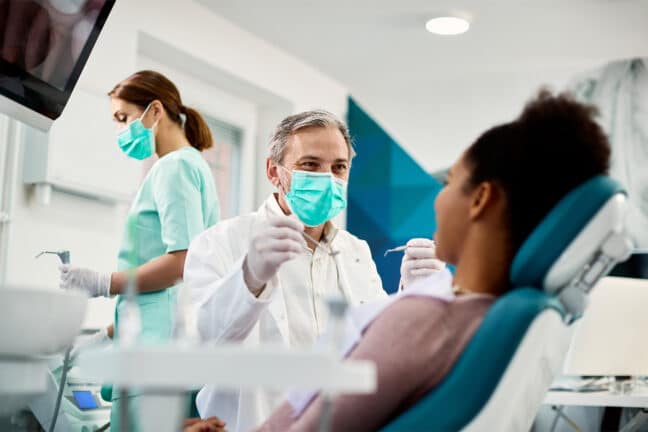“You need a root canal.” Those words often elicit fear in people who may have heard stories about how painful someone’s root canal was or the long recovery process. Fortunately, those stories are from when root canals weren’t as advanced as today. When you get root canal therapy at Leading Edge Specialized Dentistry, our highly trained endodontists perform this treatment using the latest technologies for a comfortable experience and quick recovery.
What is Root Canal Therapy?
A tooth’s pulp is made up of soft tissue, blood vessels, and nerves. When the pulp is infected, root canal therapy removes the pulp from the tooth, and the tooth is cleaned and disinfected. The tooth is then sealed closed, and, if necessary, a crown is placed over the tooth. If a tooth is still largely intact and can be saved, root canal treatment is performed rather than extracting the tooth and is successful over 90% of the time.
Signs You May Need Root Canal Therapy
Any of the following signs may indicate you need endodontic treatment:
- A chronic toothache that is worse when you bite or chew.
- Sensitivity to hot and cold that lingers after eating and drinking.
- Puffy or inflamed, tender gums around a tooth.
- A cracked or chipped tooth.
- A pus-filled pimple or abscess on the gums.
- A discolored tooth, turning brown, gray, black, or dark yellow.
- Swelling of the jaw.
- A loose tooth without another explanation.
- Chronic bad breath or an unpleasant taste in the mouth that doesn’t go away.
The Root Canal Treatment Process
Root canal therapy is a common dental procedure designed to save a tooth that is badly decayed or infected. Whether you’re getting root canal therapy or other endodontic procedures, our experienced endodontists will begin with a thorough examination of the affected tooth, including X-rays and digital imaging to get a clear picture of the tooth’s interior to guide the doctor on the day of the procedure.
The area is numbed with local anesthesia before root canal therapy begins. Once the infection is cleaned out, the tooth is sealed closed. Finally, a crown is placed over the tooth to protect it from further infection.
What to Expect After Root Canal Therapy
Once the local anesthesia wears off, you may have mild discomfort or tenderness lasting 24-36 hours. Most patients can easily control this with an over-the-counter pain reliever. Our patients usually return to work or school the day after their root canals with no problems.
We place a temporary restoration on the tooth immediately following the root canal but will replace it with a permanent restoration in about two weeks. While waiting for the permanent restoration, avoid chewing with the treated tooth. Brush around the tooth gently and avoid crunchy, hard, or sticky foods that could dislodge the temporary restoration. When the permanent restoration is placed, you can eat without restriction and return to brushing and flossing as normal.
Why Choose Leading Edge for Root Canal Therapy?
At Leading Edge, we understand you have many options for root canal treatment. That’s why we strive to provide exceptional care at our multiple locations throughout New York and New Jersey. Our team combines advanced technology with extensive experience to ensure you receive the highest quality treatment.
While complications are rare, they can occur. Having a specialist you can trust means you’ll never have to handle a potential emergency alone. At Leading Edge, you receive personalized care backed by advanced technology and expertise.
Leading Edge is committed to offering every patient the perfect blend of cutting-edge technology, professional expertise, and attentive care. If your dentist recommends root canal therapy, our offices can provide pain-free root canals with consistently successful results.

